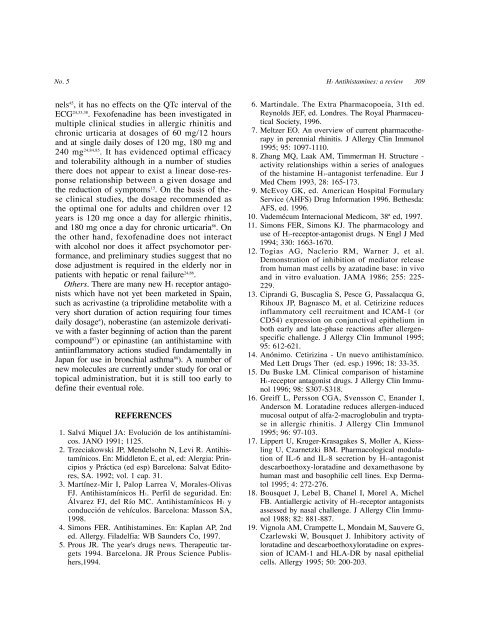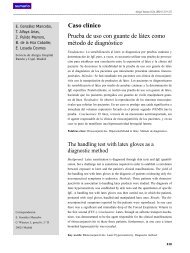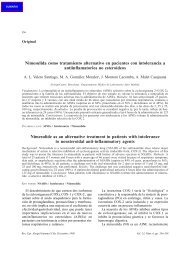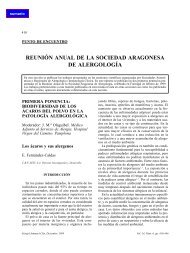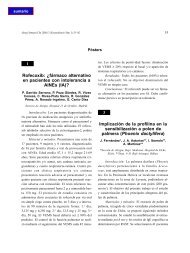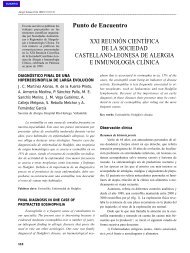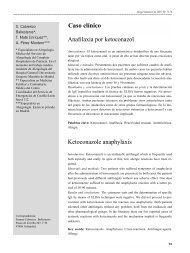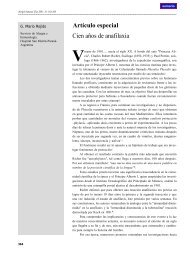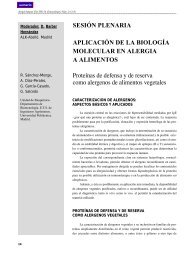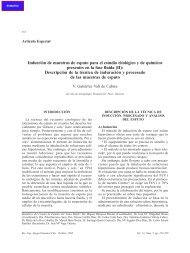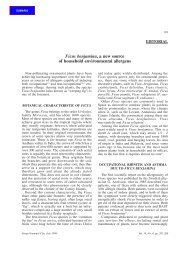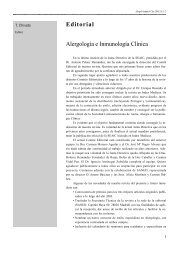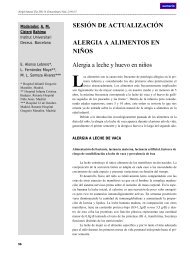Antihistamines: a review
Antihistamines: a review
Antihistamines: a review
You also want an ePaper? Increase the reach of your titles
YUMPU automatically turns print PDFs into web optimized ePapers that Google loves.
No. 5 H1 <strong>Antihistamines</strong>: a <strong>review</strong> 309<br />
nels 45 , it has no effects on the QTc interval of the<br />
ECG 24,33,38 . Fexofenadine has been investigated in<br />
multiple clinical studies in allergic rhinitis and<br />
chronic urticaria at dosages of 60 mg/12 hours<br />
and at single daily doses of 120 mg, 180 mg and<br />
240 mg 24,84,85 . It has evidenced optimal efficacy<br />
and tolerability although in a number of studies<br />
there does not appear to exist a linear dose-response<br />
relationship between a given dosage and<br />
the reduction of symptoms 15 . On the basis of these<br />
clinical studies, the dosage recommended as<br />
the optimal one for adults and children over 12<br />
years is 120 mg once a day for allergic rhinitis,<br />
and 180 mg once a day for chronic urticaria 86 . On<br />
the other hand, fexofenadine does not interact<br />
with alcohol nor does it affect psychomotor performance,<br />
and preliminary studies suggest that no<br />
dose adjustment is required in the elderly nor in<br />
patients with hepatic or renal failure 24,86 .<br />
Others. There are many new H1 receptor antagonists<br />
which have not yet been marketed in Spain,<br />
such as acrivastine (a triprolidine metabolite with a<br />
very short duration of action requiring four times<br />
daily dosage 4 ), noberastine (an astemizole derivative<br />
with a faster beginning of action than the parent<br />
compound 87 ) or epinastine (an antihistamine with<br />
antiinflammatory actions studied fundamentally in<br />
Japan for use in bronchial asthma 88 ). A number of<br />
new molecules are currently under study for oral or<br />
topical administration, but it is still too early to<br />
define their eventual role.<br />
REFERENCES<br />
1. Salv‡ Miquel JA: Evoluci—n de los antihistam’nicos.<br />
JANO 1991; 1125.<br />
2. Trzeciakowski JP, Mendelsohn N, Levi R. Antihistam’nicos.<br />
En: Middleton E, et al, ed: Alergia: Principios<br />
y Pr‡ctica (ed esp) Barcelona: Salvat Editores,<br />
SA. 1992; vol. 1 cap. 31.<br />
3. Mart’nez-Mir I, Palop Larrea V, Morales-Olivas<br />
FJ. Antihistam’nicos H1. Perfil de seguridad. En:<br />
çlvarez FJ, del R’o MC. Antihistam’nicos H1 y<br />
conducci—n de veh’culos. Barcelona: Masson SA,<br />
1998.<br />
4. Simons FER. <strong>Antihistamines</strong>. En: Kaplan AP, 2nd<br />
ed. Allergy. Filadelfia: WB Saunders Co, 1997.<br />
5. Prous JR. The year's drugs news. Therapeutic targets<br />
1994. Barcelona. JR Prous Science Publishers,1994.<br />
6. Martindale. The Extra Pharmacopoeia, 31th ed.<br />
Reynolds JEF, ed. Londres. The Royal Pharmaceutical<br />
Society, 1996.<br />
7. Meltzer EO. An overview of current pharmacotherapy<br />
in perennial rhinitis. J Allergy Clin Immunol<br />
1995; 95: 1097-1110.<br />
8. Zhang MQ, Laak AM, Timmerman H. Structure -<br />
activity relationships within a series of analogues<br />
of the histamine H1-antagonist terfenadine. Eur J<br />
Med Chem 1993, 28: 165-173.<br />
9. McEvoy GK, ed. American Hospital Formulary<br />
Service (AHFS) Drug Information 1996. Bethesda:<br />
AFS, ed. 1996.<br />
10. VademŽcum Internacional Medicom, 38» ed, 1997.<br />
11. Simons FER, Simons KJ. The pharmacology and<br />
use of H1-receptor-antagonist drugs. N Engl J Med<br />
1994; 330: 1663-1670.<br />
12. Togias AG, Naclerio RM, Warner J, et al.<br />
Demonstration of inhibition of mediator release<br />
from human mast cells by azatadine base: in vivo<br />
and in vitro evaluation. JAMA 1986; 255: 225-<br />
229.<br />
13. Ciprandi G, Buscaglia S, Pesce G, Passalacqua G,<br />
Rihoux JP, Bagnasco M, et al. Cetirizine reduces<br />
inflammatory cell recruitment and ICAM-1 (or<br />
CD54) expression on conjunctival epithelium in<br />
both early and late-phase reactions after allergenspecific<br />
challenge. J Allergy Clin Immunol 1995;<br />
95: 612-621.<br />
14. An—nimo. Cetirizina - Un nuevo antihistam’nico.<br />
Med Lett Drugs Ther (ed. esp.) 1996; 18: 33-35.<br />
15. Du Buske LM. Clinical comparison of histamine<br />
H1-receptor antagonist drugs. J Allergy Clin Immunol<br />
1996; 98: S307-S318.<br />
16. Greiff L, Persson CGA, Svensson C, Enander I,<br />
Anderson M. Loratadine reduces allergen-induced<br />
mucosal output of alfa-2-macroglobulin and tryptase<br />
in allergic rhinitis. J Allergy Clin Immunol<br />
1995; 96: 97-103.<br />
17. Lippert U, Kruger-Krasagakes S, Moller A, Kiessling<br />
U, Czarnetzki BM. Pharmacological modulation<br />
of IL-6 and IL-8 secretion by H1-antagonist<br />
descarboethoxy-loratadine and dexamethasone by<br />
human mast and basophilic cell lines. Exp Dermatol<br />
1995; 4: 272-276.<br />
18. Bousquet J, Lebel B, Chanel I, Morel A, Michel<br />
FB. Antiallergic activity of H1-receptor antagonists<br />
assessed by nasal challenge. J Allergy Clin Immunol<br />
1988; 82: 881-887.<br />
19. Vignola AM, Crampette L, Mondain M, Sauvere G,<br />
Czarlewski W, Bousquet J. Inhibitory activity of<br />
loratadine and descarboethoxyloratadine on expression<br />
of ICAM-1 and HLA-DR by nasal epithelial<br />
cells. Allergy 1995; 50: 200-203.


